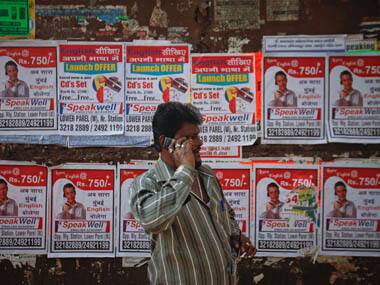On Monday, the Telecom Regulatory Authority of India’s (Trai) proposed a near 10-fold increase in the price of 2G spectrum, a move seen as another blow to telecom companies in the cut-throat sector.Trai recommended an auction starting price of Rs 3,622 crore for every megahertz (Mhz) of nationwide spectrum in the 1,800 band.
The new recommendations have raised the prospect of a higher cost structure for all telcos, and will impact telecom companies like Uninor and Sistema that want to hold on to the licences that were awarded to them in January 2008 by A Raja. Rival telcos have, therefore, returned to the lobbying war in real earnest, even as the government studies Trai’s proposals.
[caption id=“attachment_290673” align=“alignleft” width=“380” caption=“Chandrasekhar said an auction is the best way to determine the price of a natural resource. Reuters”]
 [/caption]
[/caption]
But will Trai’s proposals really sound-the deathknell of the industry? Is it all that ruinous, or is the industry crying wolf prematurely?
Telecom Secretary R Chandrasekhar, who is still to go through the fineprint of Trai’s proposals, believes that this is a wake-up call for the industry which has managed to have an easy time so far. Moreover, the industry may have glossed over the good bits in all the furore over high reserve prices for spectrum.
In an interview with DNA, Chandrasekhar said an auction is the best way to determine the price of a natural resource and he is confident of the sector transforming itself with a more liberalised and transparent policy.
Impact Shorts
More ShortsHe argues that the Trai recommendations has liberalised spectrum by allowing operators to use any technology of their choice in the bands of spectrum that they hold. Basically an operator can now offer 4G services on a 2G band.
“Liberalised spectrum you can use for any technology - 2G, 3G, 4G or any future technology which gets developed. Since this allocation is for 20 years, any benefit from technological advances can be availed,” he said. This means the burden of choice is transferred on the operator where it rightly belongs. Moreover, instead of the government deciding what technology should be used, it is now being market determined - and that too through an auction route among people who are actually providing the service. “So people will bid what they think is viable,” he said.
Secondly, even if Trai has enhanced the spectrum fee, it has drastically brought down the proportion of revenues that the operators have to give to the government as user charges.
“Today, spectrum usage charge is 3-8 percent of the adjusted gross revenue (AGR); Trai has recommended it should be brought down to 1 percent. One has to make a calculation to see what is the impact of this over 20 years,” he says.
As the revenues earned by operators run into crores and crores, any drop in the revenue share can lead to huge savings. According to a Times of India calculation, Airtel, Vodafone, Idea Cellular and Reliance Infocom will gain Rs 1,20,000 crore in the next 20 years in the circles where old licences will expire between 2014 and 2016, provided their revenues grow at a conservative 12 percent per annum.
Thirdly, the problem with the 3G auction was that the entire amount had to be paid upfront. But the fresh round of bidding for 2G auction aims at smoothening out the cash flow. “Trai has recommended only 33 percent payment upfront and after a two-year moratorium, rest of the amount should be paid in installments over 10 years.”
But even he agrees there may be loophoples with Trai’s proposals which would ideally take around a month’s time for DoT to review. However, the telecom department is trying to complete it in merely 10 days in order to expedite the auction process.
)